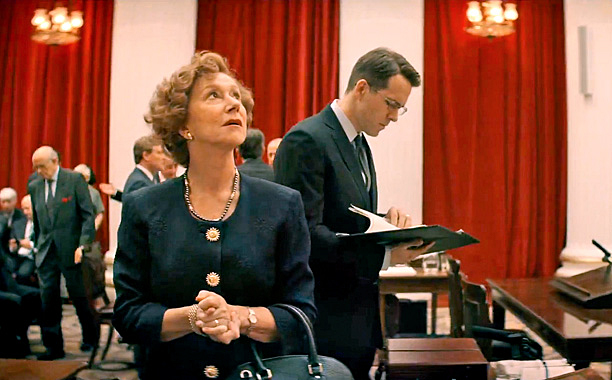At best, “Woman in Gold” is a mediocre film, competently crafted but painfully undramatic. Aside from boasting Helen Mirren, who carries “Woman in Gold” on her able shoulders, it is nothing more than your average feel-good flick. Mirren does her best with a shallow script and director Simon Curtis’ (“My Week with Marilyn”) poor execution.
The film focuses on the true story of Maria Altmann (Mirren), an elderly Jewish woman who fled Austria after the Nazi invasion and settled in California. Maria wants to begin a legal battle to regain a painting of her aunt, which is Gustav Klimt’s “Portrait of Adele Bloch Bauer I.”
Maria recruits young and inexperienced lawyer Randol Schoenberg (Ryan Reynolds) to help her reclaim the portrait, one of hundreds of paintings the Nazis stole, but the portrait is an Austrian icon that the country refuses to give up.
Mirren brings “Woman in Gold” much-needed energy, adopting a Viennese accent and delivering her comedic lines with lively wit. Reynolds barely holds his own against Mirren on screen and doesn’t display much emotional depth beyond one crying scene. He doesn’t give any memorable moments, often fading into the background while other characters steal the spotlight.
Curtis and screenwriter Alexi Kaye Campbell overly simplify the issue of who rightfully owns the portrait. Instead of examining both sides of the conflict, they they pit the righteous Maria and Randy against the mustache-twirling, villainous Austrians and their arrogant establishment. This simple-minded writing does not suit an adult-oriented drama.
The overbearing score by Martin Phipps and Hans Zimmer tries to make the audience feel what Curtis’ direction fails to communicate. Whenever a scene attempts to convey sadness, a somber piano score kicks in. The writing never manages to evoke any strong emotions on its own.
The clichéd dialogue aims for quick laughs rather than meaningful character development. The characters themselves repeatedly hammer the film’s many messages into our heads. Among them are the usual “never give up,” “underdogs can win” and “the Nazis did a lot of bad stuff.”
“Woman in Gold” barely works as entertainment. Surprise, surprise — watching lawyers bicker about loopholes in wills gets old really fast. The film consistently portrays Maria and Randy as in the right. Its three courtroom scenes favor Maria so much that there’s never any doubt she will win back the portrait. Without the drama to pull you in, you’ll glance at your watch more times than you can count.
The film’s most effective scenes are the flashbacks to Maria’s early life in Vienna. Her family life crumbles apart as the Nazis gradually take over Austria, and her heart-pounding escape from her home offers is thrilling. Curtis doesn’t depict the dehumanization of the Jews in a manner as brutal as Steven Spielberg did in “Schindler’s List,” but he still conveys the tragedy of the event.
While the story of “Woman in Gold” is worth telling, Curtis and Campbell don’t do it justice. It feels like a Lifetime movie with a big budget that’s better fit for television. At least falling asleep is more preferable on your couch than in a theater chair.





















